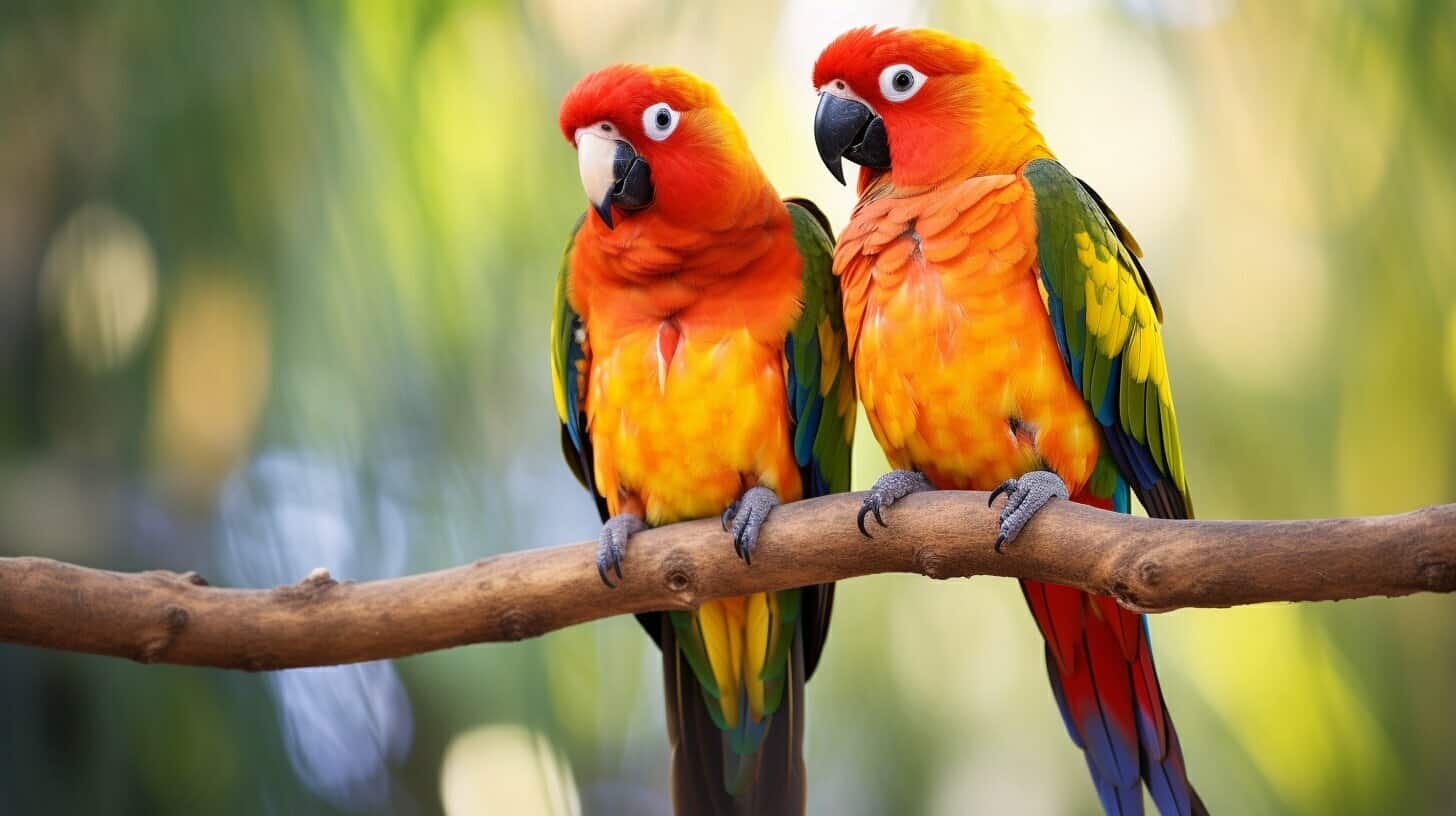Many bird enthusiasts wonder if their conures and kakarikis can live together as pets. Although these birds may seem compatible due to their similar size and appearance, several factors need consideration before housing them together. This section will provide expert advice on the compatibility between conures and kakarikis and the factors to consider when living together.
Can conures and kakarikis live together? Conures and kakarikis can sometimes coexist, but caution is advised. While both are parrots with unique behaviours, it’s essential to remember that every bird has its personality. Introducing them slowly, under close supervision, is vital to gauge compatibility. Many factors, such as individual temperaments, cage size, and previous social experiences, can influence their ability to live harmoniously. Some pairs might get along, while others may show aggression. It’s always best to monitor them closely and ensure each bird has its safe space.
Key Takeaways
- Conures and kakarikis have different socialisation needs and temperaments as pets.
- Their compatibility depends on size, behaviour, and habitat requirements.
- Creating a suitable living environment and gradual introduction is crucial for a harmonious cohabitation between conures and kakarikis.
Understanding Conures and Kakarikis
Conures and kakarikis are popular pet birds with unique characteristics and socialization needs. Before considering keeping them together, it is important to understand their traits and behaviours.
Conures as Pets
Conures are medium-sized parrots known for their playful and affectionate personalities. They are highly intelligent and social birds that enjoy the company of humans and other birds. Conures are vocal, capable of learning words and phrases and expressing a range of emotions through their calls and body language. They require daily interaction, mental stimulation, and physical exercise, making them ideal for owners who can devote plenty of time to their care.
Kakarikis as Pets
Kakarikis are small to medium-sized parakeets native to New Zealand. They are known for their friendly and curious personalities and are highly intelligent birds, requiring much mental stimulation and physical exercise. Kakarikis are playful and energetic, often entertaining their owners with their acrobatic displays and vocalisations. They are also independent birds, capable of entertaining themselves for long periods, making them ideal pets for those who have busy schedules.
Socialisation Needs
Both species have different socialisation needs that should be carefully considered before housing them together. Conures thrive in social environments and require daily human interaction and mental stimulation. They also enjoy the company of other birds, especially those of similar size and temperament. On the other hand, kakarikis are social birds but are not as dependent on human interaction as conures. They prefer the company of other kakarikis and are often kept in pairs or small groups.
“Conures are highly intelligent and social birds that enjoy the company of humans and other birds.”
When kept together, it is important to ensure that each bird has enough space and resources to satisfy their individual needs. They should also have the opportunity to socialise with each other gradually, allowing them to establish their hierarchy and form positive relationships. Observing their interactions is crucial to preventing potential conflicts and ensuring their well-being.
Compatibility and Housing Considerations
When it comes to keeping conures and kakarikis together, compatibility is key. While these two species can cohabit harmoniously, it is important to consider their size, temperament, and habitat requirements. Both are highly social birds and require ample space to move around and play in their environment.
Providing separate feeding areas and toys is important to prevent potential conflicts. Additionally, monitoring their behaviour regularly and intervening in any signs of aggression or illness is crucial.
Housing conures and kakarikis together
When housing conures and kakarikis together, providing a cage that accommodates both species’ needs is important. The cage should be spacious, at least 3 feet wide, and adequately equipped with perches, toys, food, and water dishes.
To ensure that conures and kakarikis have adequate space to socialize and play, it is also important to let them out of the cage regularly, providing a dedicated play area.
Feeding and dietary requirements
Conures and kakarikis have slightly different feeding requirements. While both enjoy fresh fruits and vegetables, kakarikis require a higher protein content, while conures need more fat. Providing a well-balanced diet that accounts for each species’ specific needs is important.
Providing separate food dishes for each species is recommended to prevent conflicts and ensure they receive the appropriate nutrition.
Monitoring their behaviour
It is important to regularly monitor the behaviour of conures and kakarikis when housed together. If you notice any signs of aggression or illness, it is crucial to intervene promptly, providing separate areas if necessary until the issue is resolved.
By considering these factors, you can create a living environment that accommodates both conures and kakarikis’ needs and promotes positive interactions, ensuring a harmonious cohabitation between these two species.
Introducing Conures and Kakarikis
Introducing conures and kakarikis requires a gradual and careful approach to ensure successful cohabitation. Here are some steps to follow:
- Separation: Keep the birds in separate cages initially but in the same room, allowing them to get used to each other’s presence. This step can take several weeks, depending on the birds’ behaviour.
- Positive reinforcement: Reward positive behaviour with treats like fruits or vegetables. Encourage the birds to interact with each other through the cage bars, but be cautious of any aggressive behaviour.
- Familiarisation: Allow the birds to interact in a neutral space, such as a play area, while supervised. This step should only be taken once the birds have shown no signs of aggression towards each other. It is important to ensure enough perches and toys for both birds to prevent territorial disputes.
- Monitoring: Keep an eye on the birds during the first few interactions outside their cages, and be prepared to intervene if necessary. Gradually increase the time the birds spend together, but always watch their behaviour closely.
- Final integration: Once the birds have successfully interacted and shown no signs of aggression towards each other, they can be housed together in a cage suitable for their size and needs.
Remember that every bird is different, and the time it takes for them to adjust to each other may vary. Always prioritize the birds’ safety and well-being, and be prepared to separate them if necessary.
Conclusion
In conclusion, conures and kakarikis can live together but require careful consideration and proper planning. As we have explored, these birds have different characteristics and socialization needs, which can impact their compatibility and cohabitation.
If you decide to house conures and kakarikis together, creating a suitable living space that accommodates their needs and encourages positive interaction is important. This can include providing adequate space, toys, perches, and food and water sources.
Additionally, introducing conures and kakarikis requires a gradual and supervised approach in which their interactions are closely monitored to prevent potential conflicts. Following the steps outlined and seeking expert advice if necessary, you can increase the chances of a harmonious cohabitation between these two species.
Making the Right Choice
Ultimately, the decision to house conures and kakarikis together should be based on carefully evaluating their needs and compatibility. If you are unsure whether these birds are suitable pets for your household, seeking experienced advice from veterinarians or bird behaviourists is important.
With proper planning and attention to their needs, conures and kakarikis can make wonderful companions for each other and their human owners.
FAQ
Q: Can conures and kakarikis live together?
A: Yes, Conures and kakarikis can coexist harmoniously as pets if certain factors are considered and appropriate measures are taken.
Q: What should be considered when housing conures and kakarikis together?
A: When housing conures and kakarikis together, their size, temperament, and habitat requirements should be considered to ensure a suitable living space for both species.
Q: Are conures and kakarikis compatible?
A: Conures and kakarikis can be compatible if their individual characteristics and socialization needs are understood and catered to.
Q: How should conures and kakarikis be introduced to each other?
A: Proper introduction is crucial for successful cohabitation between conures and kakarikis. Step-by-step guidance should be followed to ensure a smooth transition and minimize potential conflicts.
Q: Can conures and kakarikis interact positively?
A: Conures and kakarikis can interact positively and create a harmonious living environment with proper understanding and planning.
Further Reading
If you found this article interesting or useful, you should also read this article: Can Kakarikis Live with Other Birds?



Have comments or questions about this article? Then get involved!
Spotted an error or something we have missed? Let us know